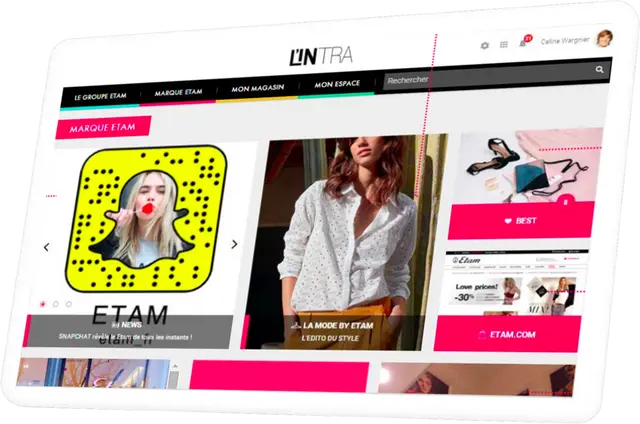

10 Great Ways to Empower Frontline Employees
Frontline, or deskless, employees are the field staff of a business or organization — think healthcare workers, service technicians and trucking professionals, to name just a few. These crucial but often unheralded workers power critical functions at enterprises, and their ability to perform their jobs effectively has a dramatic effect on company reputation.
But do most frontline workers experience high levels of job satisfaction and engagement? Unfortunately, no.
Frontline employees are more likely to be disengaged from their organization as a result of being disconnected from today’s methods of employee communications i.e., email, e-newsletters, social intranets and other digital communications. In fact, in many industries that employ frontline workers, the turnover rate is high as a result of this disengagement. It’s estimated that replacing an employee costs up to 33 percent of their yearly salary, so it’s easy to see why taking proactive measures to engage and empower them is important.
How can we empower frontline employees?
According to a study by the Harvard Business Review, 87% of respondents feel their companies will achieve more success when the frontline staff is empowered to make on-the-spot decisions. How do you get there if you’re used to a high-churn employment model?
We’ve outlined 10 ways to help your organization along its journey.
1. Present a clear vision
Frontline workers often feel disconnected from corporate. This is why it’s so important to instill corporate values and mission statements in all frontline staff. They aren’t just words — they are the purpose your business has for operating, and the culture you craft from these values needs to permeate the entire hierarchy.
When an employee understands the goals and purpose of an organization, they begin to adapt them to their own objectives and purpose in their position. Essentially, these ideals connect them to the bigger picture and leave them more fulfilled with their work.
2. Provide more robust technology solutions
Another insight from the Harvard Business Review study mentioned above is that 86% of those surveyed say their frontline employees require better technology tools. With this in mind, it does good to emphasize that digital transformation isn’t only for desk workers.
Research by McKinsey & Company suggests that 43% of organizations who digitally empower their frontline staff see excellent progress in their digital transformation efforts. Compare that to a measly 21% for organizations that are not providing technology upgrades to frontline employees, and it’s easy to see how it’s beneficial.
An elegant solution such as a social intranet that includes a mobile app is an effective way to give frontline employees the tools and information they need to stay connected. Social intranets serve as a unified central hub that can dispense pertinent company information to targeted groups of users whether they are inside an office using a desktop computer or out in the field using a mobile device. The most effective ones integrate seamlessly with popular scheduling, communication and feedback applications to make empowering frontline employees easy and efficient.
LumApps, the Employee Experience Platform
3. Give frontline staff decision-making abilities
Since many frontline employees are in the field interacting with customers on a daily basis, they have insights that you can’t get from anywhere else. This is why nearly 90% of those surveyed in the HBR study agree on the importance of an empowered frontline staff.
Some organizations utilize customer surveys as the main driver of customer service-related decisions. While surveys are a great tool, they may not provide a truly representative sample because their questions often lead participants toward certain answers.
When you rely on an engaged frontline workforce, customer behavior is taken into account in a more efficient manner. Employees interact with customers in a more candid and personal way, which often removes the film of any obligated niceties or influenced responses. As a result, frontline workers hold a unique perspective in terms of customer expectations and experience.
With this in mind, be sure to empower frontline staff to make important customer service and business decisions. Not only will this be better for the customers, but it will also make employees feel less interchangeable and more important to business operations.
4. Solicit regular feedback
A recent study concludes that over half of frontline workers have suggestions and feedback to improve customer satisfaction quarterly. If you aren’t asking for these suggestions at least quarterly, you’re missing out on many great ideas. Set open office hours when workers can give their feedback before or after their shifts.
Combine this measure with a technology-based solution such as a social intranet with mobile access so employees can give feedback at any time. Then you can follow up with them in person at a convenient time and discuss things in more depth.
5. Invest in better onboarding resources
2019 research indicates that 38% of frontline workers received no formal training. Another 27% said the training they did receive was insufficient, boring, and ineffective. This puts more stress and anxiety on new frontline staff from the very first day of employment. It’s no wonder these people are so unengaged.
Invest in solid, engaging training programs that set your frontline workers up for success.
Employee Engagement
Time to start or overhaul an engagement strategy? Capitalize on Employee Engagement Opportunities.

6. Communicate results
If you’ve presented a clear vision, provided proper training and empowered frontline employees to make day-to-day decisions, it’s important to track progress on work-related goals. If they have a monthly sales quota they need to hit, inform them about their trajectories weekly and discuss ideas to improve performance when necessary.
7. Recognize and reward high performance
An employee who doesn’t feel recognized is twice as likely to quit their job within the year. Even if you think you’re recognizing high performers as much as you need to, your employees probably share a different opinion. An estimated 67% of managers think they provide enough recognition, but only 23% of workers agree with them. It’s never a bad idea to increase your recognition efforts, as it helps build company morale and increases job satisfaction.
Collaborative technology solutions such as a social intranet have built-in recognition tools for managers and peers. It allows both employees and management to recognize good performance with the touch of a finger. This will have a major impact on employee morale.
8. Value their opinions
Don’t stop at collecting feedback regularly. Many frontline workers have great suggestions to improve the experience they offer their end-users and colleagues. If someone has a good idea, implement it.
Even if management decides an idea is not feasible, it’s important to communicate the reasons behind the decision to the frontline worker. This lets them know that, while you will not be going forward with their idea, it was at least heard and considered. The worst thing you can do is ask for feedback and go completely silent as to its progress. When this happens, workers feel as if they’re sending their ideas into the ether, never to be heard of again.
9. Foster a team culture
Building a culture of teamwork and collaboration is a terrific way to motivate frontline employees. The previous tips go a long way in fostering a team-oriented culture, but if you go the extra mile, it will do wonders. For example, you could set up designated monthly team-building activities after shifts. This lets everyone get to know each other outside the workplace and builds camaraderie.
Employee Engagement
Time to start or overhaul an engagement strategy? Capitalize on Employee Engagement Opportunities.

10. Provide growth opportunities
Recent research says that 93% of employees would stay at their company if it provided ample growth opportunities. This means it’s crucial to invest in your frontline workers if you want to reduce turnover.
Implement manager-in-training programs and upskill workers for other positions in order to give them the best possible chance for success within your organization. This approach motivates frontline staff to be more loyal and work harder because they know they have the possibility of advancement on the horizon.
Finally, implementing powerful technological solutions such as LumApps for Frontline Workers can give staff a platform for success.
Discover our latest content on Employee Engagement
- What is Employee Engagement? Benefits, Strategies & Steps
- Why is Employee Engagement so Important? TOP 20 Benefits
- Best 15 Employee Engagement Strategies in 2023
- What is Brand Advocacy? How do You Build and Drive it?
- 10 Steps to Create a Strong Employee Engagement Action Plan
- 30 Employee Engagement Best Practices to Follow in 2023
- 15 Key Factors Influencing Employee Engagement in 2023
- 50+ Employee Engagement Ideas and Strategies for Companies
- Top 10 Employee Engagement KPIs: The Metrics to Measure
- 15 Best Features for Your Employee Engagement Software
- Top 30 Questions to Conduct an Employee Engagement Survey
- 20 Easy Ways to Motivate Employees
- Top 10 Employee Retention Strategies & Ideas to Set up
- Employee Social Advocacy for HR and Recruiters
- 10 Great Ways to Empower Frontline Employees | LumApps
- How Employee Advocacy Can Help Your Brand Build Trust
- How to measure employee satisfaction: Best methods and key metrics to track
- How to Boost Morale at Work? 30 Strong Ideas
- 15 Proven techniques to keep employees engaged and motivated
- The HR Guide to Effective Employee Engagement Metrics
- Top 10 Ways to Improve Employee Satisfaction
- Social Advocacy for Business Benefits
- 6 Tips To Build a Strong Employee Advocacy Program
- 30+ Virtual Team Building Activities for Companies in 2023
- Employee Advocacy on Social Media: Benefits, Examples & Strategies
- What is Employee Retention and How to Manage it?
- A Guide for Reducing Employee Turnover





